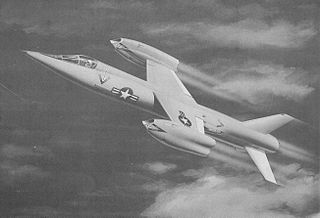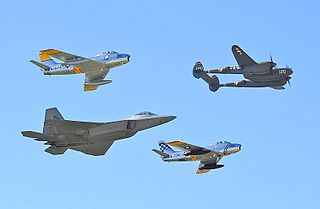
The Douglas D-558-2 Skyrocket is a rocket and jet-powered research supersonic aircraft built by the Douglas Aircraft Company for the United States Navy. On 20 November 1953, shortly before the 50th anniversary of powered flight, Scott Crossfield piloted the Skyrocket to Mach 2, or more than 1,290 mph (2076 km/h), the first time an aircraft had exceeded twice the speed of sound.

The DFS 346 was a German rocket-powered swept-wing aircraft which began development during World War II in Germany. It was designed by Felix Kracht at the Deutsche Forschungsanstalt für Segelflug (DFS), the "German Institute for Sailplane Flight". A prototype was constructed but did not reach completion before the end of the war. It was taken to the Soviet Union where it was completed, tested and flown.
The Dassault Étendard VI was a French prototype fighter aircraft initially developed as part of the NATO NBMR-1 competition to find a standard fighter to serve amongst member air forces. Dassault took advantage of the fact that the French Air Force had issued a requirement around the same time for a new fighter-bomber and developed aircraft in parallel as variations of the same design concept for the two prospective customers.

The Bell D-188A was a proposed eight-engine Mach 2–capable vertical take-off and landing (VTOL) tiltjet fighter that never proceeded past the mock-up stage.

The Convair XF-92 was an early American delta wing aircraft. Originally conceived as a point-defence interceptor, the design was later used purely for experimental purposes. However, it led Convair to use the delta-wing on a number of designs, including the F-102 Delta Dagger, F-106 Delta Dart, B-58 Hustler, the US Navy's F2Y Sea Dart as well as the VTOL FY Pogo.
The Breguet Br.960 Vultur was a French prototype carrier-based attack aircraft that first flew on 3 August 1951. Only two examples were built, but the work done on them later proved useful in the development of the Breguet Alizé anti-submarine warfare aircraft.

The Dassault MD.452 Mystère is a 1950s French fighter-bomber.

The Cessna Citation family is Cessna's business jets line. The 7,000th Citation was delivered on June 27, 2016, forming the largest business jet fleet: the first Citation was put into service in 1972 and more than 35 million flight hours have been logged since.

The Messerschmitt P.1101 was a single-seat, single-jet fighter project of World War II, developed in response to the 15 July 1944 Emergency Fighter Program which sought a second generation of jet fighters for the Third Reich. A characteristic feature of the P.1101 prototype was that the sweep angle of the wings could be changed before flight, a feature further developed in later variable-sweep aircraft such as the Bell X-5 and Grumman XF10F Jaguar.
The Sukhoi Su-15 was a prototype Soviet all-weather interceptor which never reached production. The name was later reused for an entirely different 1960s interceptor, see Sukhoi Su-15.

The Breguet Br.1001 Taon was a 1950s French prototype single-seat jet strike fighter aircraft built by Breguet.

The SNCASE S.E.5000 Baroudeur was a French single-engined lightweight fighter designed by SNCASE (Sud-Est) for the NATO NBMR-1 "Light Weight Strike Fighter" competition. An unusual design without a conventional landing gear, it used a wheeled trolley for take-off and three retractable skids to land. The Baroudeur did not enter production.

The Lavochkin La-152,, and its variants, was a jet fighter prototype designed and manufactured by the Lavochkin Design Bureau (OKB) shortly after the end of World War II. Derived from the Lavochkin La-150, the 152 used several different engines, but the program was canceled as other fighters with more powerful engines and swept wings showed more promise.

The Yakovlev Yak-1000 was a Soviet supersonic technology demonstrator intended to evaluate the aerodynamic layout and field performance of the cropped delta wing discussed in captured German documents in combination with the new Lyulka AL-5 turbojet. The tandem undercarriage proved to be unsatisfactory and there were serious flight stability problems related to the delta wing, enough so that it never flew after an accident during taxiing tests.

The Dassault Mirage F2 was a French prototype two-seat attack fighter which was designed to serve as a test bed for the SNECMA TF306 turbofan engine and influenced the similar variable-geometry Dassault Mirage G.
The SNCASO SO.4000 was an experimental French twin-engine jet-bomber aircraft of the 1950s. Only a single example was built, which only made a single test flight before development was abandoned.

The Mikoyan-Gurevich I-320 was a prototype Soviet long-range all-weather interceptor aircraft of the late 1940s-early 1950s. Only two were made, with no production following.

The SNCAC NC-600 was a prototype French twin-engined long-range fighter aircraft, developed by SNCAC from the earlier Hanriot H.220 fighter. The type never entered service, with development being ended by the French surrender in June 1940.

The Sud-Ouest SO.6020 Espadon was a post-war prototype French interceptor designed and built by SNCASO. Only four aircraft were built and the type did not go into production.
The Mikoyan-Gurevich I-7 was a development of the Mikoyan-Gurevich I-3 experimental fighter. Planned as a Mach 2-class aircraft, the I-7 was the second of a series of three experimental fighter aircraft from the Mikoyan-Gurevich design Bureau. Like the Mikoyan-Gurevich I-3, the I-7 was to be one of the components of the automated Uragan-1 then under development by protivovozdushnaya oborona strany, the Soviet defense system.

























